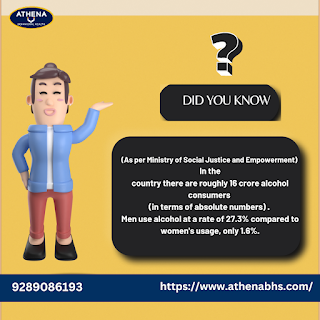It is a well known fact that many psychoactive substances including alcohol, cannabis, and opioids have been used in India for millennia, there is little information available about the present extent and pattern of this use, as well as the issues it causes.
The Government of India's Ministry of Social Justice and Empowerment (MoSJE) ordered a National Survey on the Extent and Pattern of Substance Use in India in an attempt to fill this gap.
●Indians most frequently use alcohol as a psychoactive substance (among the substances included in this survey).
Between 10 and 75 years old, 14.6% of the population nationwide uses alcohol. In thecountry there are roughly 16 crore alcohol consumers (in terms of absolute numbers) . Men use alcohol at a rate of 27.3% compared to women's usage, only 1.6%.The states with the highest rates of alcohol use include Goa, Punjab, Arunachal Pradesh, Tripura, and Chhattisgarh.
Country liquor, also known as "desi sharab,"
and spirits, also known as Indian Made Foreign
Liquor, are the most popular
alcoholic beverages among drinkers (approximately 30% each).
● Cannabis and opioids are the second most popular drugs in India after alcohol.
The authorised form of cannabis (bhang) and other
illicit cannabis products were further distinguished
in terms of cannabis consumption (ganja and charas). Bhang use was seen to be about 2% (or roughly 2.2 crore people)
and illegal cannabis product use to be about 1.2% (or roughly 1.3 crore people). Uttar Pradesh, Punjab, Sikkim,
Chhattisgarh, and Delhi have the highest
rates of cannabis consumption per capita.
● Opioids, such as opium (or its derivatives such poppy husk known as doda/phukki), heroin (or its impure form, smack or brown sugar), and a range of pharmaceutical opioids, are used by about 2.1% of the country's population, or 2.26 crore people. Opioids used most frequently in the country are heroin (1.14%), prescription opioids (0.96%), and opium (0.52%). The states with the highest frequency of opioid use in the general population (more than 10%) are Sikkim, Arunachal Pradesh, Nagaland, Manipur, and Mizoram.
The recent survey's finding that heroin usage is far
more common in India than opium use
is noteworthy when it comes to opioids.
●The only substance category for which children and adolescents are more likely than adults to report current usage (1.17% vs. 0.58% total prevalence) is inhalants (0.7%).
● In India, a wide range of pharmacological medications are used, all of which have the characteristics of being sedative-hypnotics and having a high potential for addiction. Many of these items have valid and significant medical uses.
Around 1.18
crore persons in India, or 1.08% of the population, currently take
sedatives. The use of sedatives is more prevalent in some Indian states than others, is the case with other drugs. The three states with the highest rates of current sedative usage are Mizoram (3.8%), Nagaland (5.4%), and Sikkim (8.6%). However, the top five states with the highest sedative use rates are Uttar Pradesh, Maharashtra, Punjab, Andhra Pradesh and Gujarat.
●Male
users of cocaine are estimated to make up 0.18% of Indians, while female
users make up 0.01%. This translates to around 10.7 lakh current
cocaine users in the nation. The percentage of people
who use cocaine in a dangerous and
dependent manner is likewise quite low (0.03%). Maharashtra, Punjab, Rajasthan, and Karnataka are
states with significant numbers of active cocaine
users.
● A small percentage of Indians also use Amphetamine Type Stimulants (ATS), same to how they do cocaine. The prevalence in the general population is 0.18%. (i.e. about 19.4 lakh individuals). On a national level, it is estimated that 7 lakh people (or slightly under 0.06%) use ATS in a detrimental or dependent manner. Maharashtra , Telangana (2.4 lakh), Uttar Pradesh, Punjab and Manipur are states with significant populations of ATS users. There arealso an estimated 50,000 ATS users in Delhi.
● 3.4
lakh Indians, or around 0.03% of the population, require assistance due to their dangerous or compulsive use of
hallucinogens.
The states of Maharashtra, Telangana, Kerala, and Delhi have significant populations of users of hallucinogens.
Treatment
2.6% of all alcohol-dependent adults who attempted to quit reported obtaining any support or treatment, or roughly 25% of those who tried to quit. Spiritual / religious
help was the most common type of assistance among those who received assistance or treatment (33%) and was followed by a "government doctor or health facility" (25%). Only 21% of those who received any kind of assistance or treatment said they had been admitted to the hospital due to alcohol use problems.
The same pattern
can be seen in people
who depend on illegal narcotics. Around 44% of individuals who struggled with drug
addiction said they had tried to stop using drugs;
of these, about 25% (or roughly 12% of all drug users) said they had ever
sought help or therapy. For 40% of individuals who had received care, a government hospital was the most frequent source.
Athena
Behavioral Health is the leading provider of best de addiction
centres in Delhi . We offer affordable, high-quality treatment for
patients with a wide range of behavioral health issues including: depression,
anxiety, addiction , drug abuse, bipolar disorder, eating disorders and more.
It delivers high quality, effective
behavioral health care that improves the lives of people who suffer from mental
illness, drug addiction or both.
Read More : Detox Centers in India,
Mental
Hospital Gurgaon





No comments:
Post a Comment
If you have any doughts. Please let me know